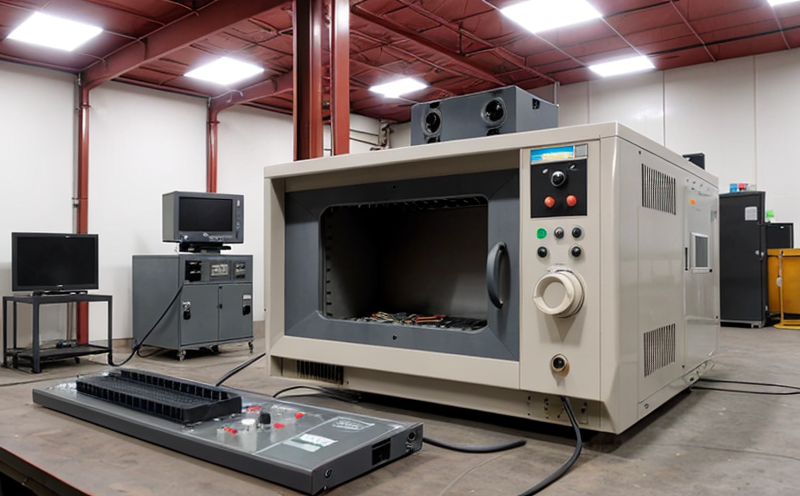ISO 14644 Environmental Testing for Industrial Cleanroom Electronics
The ISO 14644 series of standards sets out requirements and guidance for cleanroom environments, including air classification in terms of particle content. This service focuses specifically on environmental testing as per ISO 14644-3, which is essential for ensuring that industrial and commercial electronics meet stringent quality and safety requirements in cleanroom environments. Cleanrooms are critical to the manufacturing of semiconductors, medical devices, pharmaceuticals, and other industries where contamination can lead to significant operational issues.
The testing process involves a comprehensive analysis of air quality parameters such as particle size distribution, temperature, humidity, pressure differential, and airflow rates. The primary goal is to ensure that any electronic device or component produced in these environments adheres strictly to the specified cleanliness levels as defined by ISO 14644-3.
The testing procedure begins with a thorough inspection of the cleanroom itself. This involves measuring particle counts using laser-based particle counters and monitoring air flow patterns through optical probes. Once the baseline conditions are established, specific electronic components or assemblies undergo rigorous testing under controlled environmental conditions that simulate real-world scenarios within the cleanroom.
During this phase, various parameters such as temperature fluctuations, humidity variations, and pressure differentials are closely monitored to determine their impact on the performance of the tested device. The results are then compared against predefined acceptance criteria laid out in ISO 14644-3. If any parameter fails to meet these standards, corrective actions are implemented immediately.
Our laboratory uses state-of-the-art equipment like laser particle counters capable of detecting particles as small as 0.3 micrometers, flow meters for measuring air velocity, and high-resolution cameras for visualizing airflow patterns. These tools provide precise data which is crucial for ensuring compliance with ISO standards.
The importance of this service cannot be overstated given the sensitive nature of many industrial applications that require absolute purity in manufacturing processes. By adhering to these stringent environmental controls, manufacturers can significantly reduce defects and improve product reliability, ultimately leading to higher customer satisfaction and reduced production costs.
Our team comprises highly experienced professionals who have extensive knowledge not only about the technical aspects but also the business implications of meeting such high standards. We pride ourselves on providing accurate results that are critical for maintaining competitiveness in today’s marketplace.
Scope and Methodology
The scope of ISO 14644 environmental testing encompasses a broad range of parameters relevant to ensuring the cleanliness of air within industrial cleanrooms. These include particle size distribution, temperature, humidity levels, pressure differentials, and airflow rates. Each parameter plays a crucial role in maintaining optimal conditions for sensitive electronic components.
Our methodology involves several key steps which are designed to yield reliable results that can be trusted by our clients:
- Baseline Measurements: Conducting initial assessments of the cleanroom environment before introducing any test samples or assemblies.
- Test Specimen Preparation: Ensuring all components being tested have been prepared according to industry best practices.
- Environmental Control: Maintaining consistent and stable environmental conditions throughout the testing process.
- Data Collection & Analysis: Gathering detailed data points on various parameters mentioned above, then analyzing them against ISO 14644-3 criteria.
- Action Plan Development: Based on analysis results, developing appropriate corrective measures if any non-compliance is detected.
By following this structured approach, we ensure that every aspect of the testing process contributes to producing accurate and actionable insights for our clients.
International Acceptance and Recognition
The ISO 14644 series has gained widespread acceptance across various industries due to its rigorous approach towards defining cleanroom environments. Organizations worldwide recognize these standards as best practices when it comes to maintaining high levels of cleanliness in critical manufacturing facilities.
In particular, ISO 14644-3 specifically addresses the environmental requirements for electronic equipment within Class I through Class 9A cleanrooms. It provides clear guidelines on how to measure and control these factors so that they remain within acceptable limits. Compliance with these standards not only helps manufacturers meet regulatory requirements but also enhances their reputation among customers who value quality assurance.
Many leading organizations have already adopted ISO 14644 as part of their quality management systems, recognizing its value in fostering trust and reliability between suppliers and end-users alike. By adhering to these internationally recognized standards, businesses can demonstrate their commitment to excellence while simultaneously reducing risks associated with contamination or operational disruptions.
Our laboratory has earned accreditation from reputable bodies such as ANSI/NCSL, UKAS, and others, allowing us to provide testing services that are trusted by both local and international clients. We stay abreast of any updates or changes in these standards so our clients always receive the most current information available.
Use Cases and Application Examples
The application of ISO 14644 environmental testing extends beyond just electronics manufacturing into several other sectors that rely heavily on cleanroom environments. Some notable examples include:
- Pharmaceutical Manufacturing: Ensuring drug products remain uncontaminated during production.
- Medical Device Fabrication: Maintaining sterility in the assembly of surgical instruments and implants.
- Semiconductor Production: Achieving high yields by preventing dust particles from affecting wafer quality.
- Aviation & Aerospace: Guaranteeing reliability of avionics systems used in aircraft and spacecraft.
- Biotechnology Research: Protecting fragile biological samples during experimental procedures.
- Battery Manufacturing: Avoiding impurities that could compromise the performance or safety of rechargeable batteries.
In each case, strict adherence to ISO 14644 ensures that products meet stringent quality standards, thereby enhancing product reliability and customer confidence. This is particularly important in industries where even minor deviations can have serious consequences.
Our team works closely with clients across these diverse fields to understand their unique needs and develop tailored solutions for achieving compliance with ISO 14644-3 requirements.





